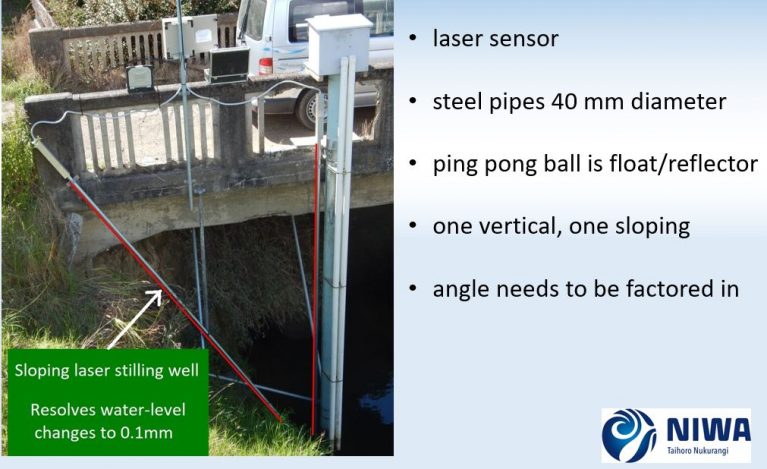Presented at NZ Hydrological Society Technical Workshop 17-20 March 2020
Abstract
To effectively manage freshwater resources we commonly need to retrieve continuous, accurate water-level data from remote sites. NIWA has developed, and is using, laser-based water level logging systems to enable this. The SDI-12 laser sensor (LWL6001-S) takes precise, non-contact water-level measurements.
The LWL6001-S is stable, has excellent repeatability and can resolve changes as small as 0.1mm. It can reveal time-series features that might go unnoticed by lower resolution or less responsive sensors. For example, at one of our trial sites near Nelson, we recorded the groundwater response to a magnitude 7.1 earthquake off East Cape – at the time, we were measuring and recording the groundwater level every 10 seconds.
Being digital from end to end, the LWL6001-S doesn’t have the analogue drift and hysteresis problems of Pressure Transducers (PTs). It also avoids the problems associated with moving parts, such as those in float and counterweight systems, and responds more rapidly.
The laser measures distance so its output is ‘closer to a primary measurement’ than pressure sensors that weigh the overhead water as a surrogate for depth, is independent of water density, gravity and doesn’t need to be calibrated, unlike submersible PTs and bubblers. It does not need to be removed for annual recalibration so ongoing operational costs are minimal.
The LWL6001 works over a wide range of water levels and, unlike PTs, does not usually need to be matched to an expected water-level range. This ‘one size fits all’ approach minimizes the number of variants that need to be held on inventory, as spares, and simplifies related field work.
The LWL6001 is being used, or trialled, in four different applications; for measuring groundwater, surface water (including pond leakage measurement) and, most recently, stormwater.
Primary surface water level measurement is traditionally carried out in a stilling well. This typically uses a counterweighted float that follows the water surface. This is mechanically coupled to a rotary encoder that converts the surface position to water level which is then electronically recorded. A co-located EPB is used to periodically verify the output from primary recorder.
The disadvantages of conventional stilling wells, with rotary encoders, is that they are physically large, therefore expensive to install and maintain, and present a potential safety hazard to hydrologists and to the public. Due to their mechanical make-up, rotary encoders can show a lagged response to water-level changes. These disadvantages are a consequence of the need for conventional stilling wells to be vertical.
Because the LWL6001-S can work in any orientation, it enabled the possibility of a superior quality, inexpensive, alternative primary water-level monitoring suitable for installation down a sloping riverbank.
We are currently trialling a prototype sloping stilling well system at Aroaro Stream near Auckland and will present these results.

Since the laser is more accurate than a conventional EPB, it begs the question, ‘could a laser also replace the traditional EPB’?
The presentation will cover applications and the results and conclusions from field trials.
Author bio
 Jeremy Bulleid is a Principal Technician currently employed by the National Institute of Water and Atmospheric Research (NIWA), working in the Christchurch-based Instrument Systems Group.
Jeremy Bulleid is a Principal Technician currently employed by the National Institute of Water and Atmospheric Research (NIWA), working in the Christchurch-based Instrument Systems Group.
His most recent work has involved applying technology to enhance science research, and reach, through innovations in environmental monitoring. Skills include design and development of technological solutions, the application of machine learning to solve environmental problems, writing technical publications and improving processes that support robust and defensible science.
Presentation
To watch the video, you will need your AHA member password sent to members by email

